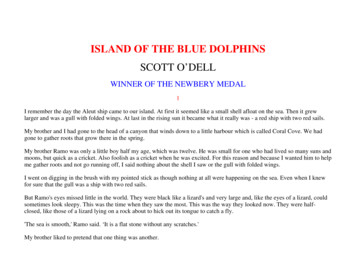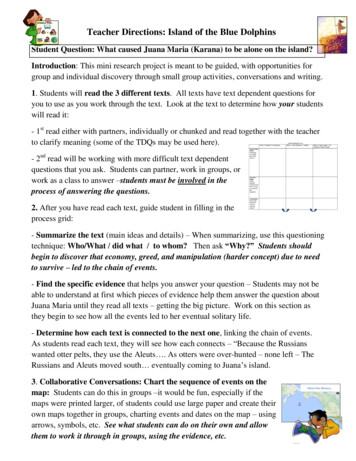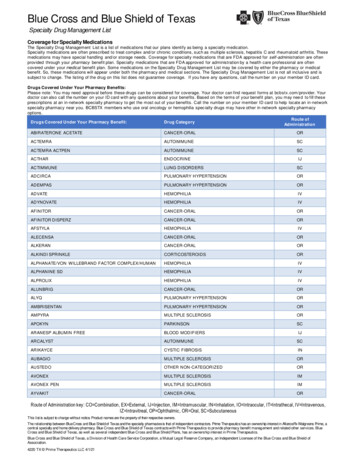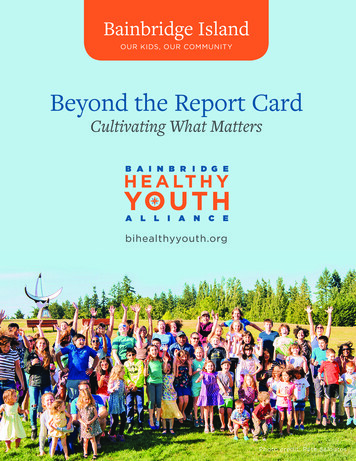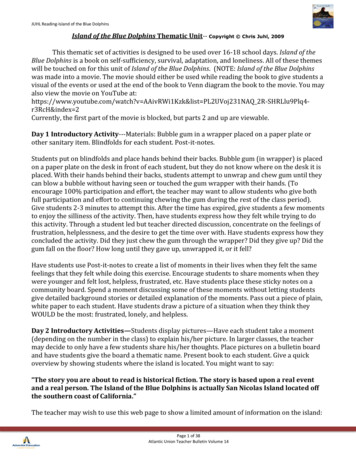
Transcription
JUHL Reading-Island of the Blue DolphinsIsland of the Blue Dolphins Thematic Unit-- Copyright Chris Juhl, 2009This thematic set of activities is designed to be used over 16-18 school days. Island of theBlue Dolphins is a book on self-sufficiency, survival, adaptation, and loneliness. All of these themeswill be touched on for this unit of Island of the Blue Dolphins. (NOTE: Island of the Blue Dolphinswas made into a movie. The movie should either be used while reading the book to give students avisual of the events or used at the end of the book to Venn diagram the book to the movie. You mayalso view the movie on YouTube at:https://www.youtube.com/watch?v AAivRWi1Kzk&list PL2UVoj231NAQ 2R-SHRLlu9Plq4r3RcH&index 2Currently, the first part of the movie is blocked, but parts 2 and up are viewable.Day 1 Introductory Activity---Materials: Bubble gum in a wrapper placed on a paper plate orother sanitary item. Blindfolds for each student. Post-it-notes.Students put on blindfolds and place hands behind their backs. Bubble gum (in wrapper) is placedon a paper plate on the desk in front of each student, but they do not know where on the desk it isplaced. With their hands behind their backs, students attempt to unwrap and chew gum until theycan blow a bubble without having seen or touched the gum wrapper with their hands. (Toencourage 100% participation and effort, the teacher may want to allow students who give bothfull participation and effort to continuing chewing the gum during the rest of the class period).Give students 2-3 minutes to attempt this. After the time has expired, give students a few momentsto enjoy the silliness of the activity. Then, have students express how they felt while trying to dothis activity. Through a student led but teacher directed discussion, concentrate on the feelings offrustration, helplessness, and the desire to get the time over with. Have students express how theyconcluded the activity. Did they just chew the gum through the wrapper? Did they give up? Did thegum fall on the floor? How long until they gave up, unwrapped it, or it fell?Have students use Post-it-notes to create a list of moments in their lives when they felt the samefeelings that they felt while doing this exercise. Encourage students to share moments when theywere younger and felt lost, helpless, frustrated, etc. Have students place these sticky notes on acommunity board. Spend a moment discussing some of these moments without letting studentsgive detailed background stories or detailed explanation of the moments. Pass out a piece of plain,white paper to each student. Have students draw a picture of a situation when they think theyWOULD be the most: frustrated, lonely, and helpless.Day 2 Introductory Activities—Students display pictures—Have each student take a moment(depending on the number in the class) to explain his/her picture. In larger classes, the teachermay decide to only have a few students share his/her thoughts. Place pictures on a bulletin boardand have students give the board a thematic name. Present book to each student. Give a quickoverview by showing students where the island is located. You might want to say:“The story you are about to read is historical fiction. The story is based upon a real eventand a real person. The Island of the Blue Dolphins is actually San Nicolas Island located offthe southern coast of California.”The teacher may wish to use this web page to show a limited amount of information on the island:Page 1 of 38Atlantic Union Teacher Bulletin Volume 14
JUHL Reading-Island of the Blue Dolphinshttp://score.rims.k12.ca.us/score lessons/dolphin/island.shtml#If you click on the island, a pop-up page will show pictures of the island and the animals that aredescribed in the book. The teacher may wish to use other sections from this web site for otheractivities while reading this book.Before going over how to do the worksheets, inform students that they will be playing their owngame of Survivor (rules detailed later) throughout this book. It would be greatly beneficial for theteacher to read and fully understand how to play the game so that he/she may give a completeexplanation to the students. After this is completed, read chapter one with the students. Use“Reading Worksheet One” with students on day two. This will help give them an initial example ofwhat is required of them. NOTE: Some answers may not be found in the book but will takeresearch outside of the book to find the correct answer.Reading activities: Several reading activities will be covered for this book. They includehighlighting, paragraphing, Venn diagramming, and writing reading notes. Take a moment on thisday to show students how to do each of these strategies.The first reading activity is using reading notes and highlighting. Students use small strips ofsticky back paper for reading notes. The students should look on the reading worksheets for astarred (*) question. This * indicates that they will need to mark information with sticky notesthroughout the reading selection to answer this question. After students have read the question,they should look for specific examples in the book, while reading it, that answer the question thatwas asked. They should then put a sticky note pointing to that line. When they are ready to answerthe question on the worksheet, they should review the notes that were made in the book. Thenotes should then be organized and used to write a paragraph.The second reading activity is paragraph writing. On various worksheets, students will be askedto give their answer(s) in paragraph form. It would be wise for the teacher to review with studentshow to transfer notes into writing a paragraph. Students will need to concentrate on a topic withsupporting details that completely answer the question. The teacher should inform students thatany paragraph that does not contain 4-6 sentences will not receive full credit.The third reading activity is Venn diagraming--Students will be required to do a few Venndiagrams during this lesson. Please take a moment to review with students how to create a Venndiagram.Students will also learn about metaphors and symbols in this book. Take a moment to explainwhat a metaphor is and how symbols are used in literature.Have the students use the animal list page to keep a list of the animals that are mentioned in thebook. Every time an animal is mentioned, the student should write this animal down on the animalpage list. Next, the student should write a detailed description of this animal. The descriptionshould NOT just be about the information found in the book. Students need to write down severalfacts about the animals from information they find on the internet, in encyclopedias, or in otheranimal books. You may want to find a few books that deal with these types of animals on yourown. Place the books in the room so that when students are finished with daily work they may usethe books to add to their lists. Students need to use the names for the animals that Karana uses.Page 2 of 38Atlantic Union Teacher Bulletin Volume 14
JUHL Reading-Island of the Blue DolphinsFor example, a devilfish is used for an octopus or squid. Please let students know that the finalreward challenge will involve their knowledge of these animals.Day 3-16 –It would be beneficial for the students to read out loud for the first 10-12 minutes ofclass on the day that the Survivor is not played. Reading on days that Survivor is played should be4-5 minutes. You may decide to grade some worksheets in class with students grading their ownworksheets and reading some thought answers out loud. Students may be able to get mostworksheets done in a day or a day and a half.Please refer back to the book link above several times during the activity to allow students to learnmore about San Nicolas sea life, geography, village life, etc.Island of the Blue Dolphins Time LineDay 1 & 2—Introduction, explanation of activities, joint reading of Chapter One—If time permits,you may wish to use excerpts of the movie to give a visual. This may be done throughout thereading of the book.Day 3 & 4—Reading of chapters 2-5 (may be either due at the end of day 4 or the beginning of day5).Day 5 & 6—Reading of chapters 6-9—Day 6 should begin with first survivor activity. Note: Thereare two worksheets for this section. Do not give the second worksheet labeled--Worksheet ThreeB—until after chapter 8 is read. It is a reading notes activity, but it reveals the death of Karana’sbrother Ramo. You do not want to give this away ahead of time.Day 7 & 8—Reading of chapters 10-13Day 9 & 10—Reading of chapters 14-17—Day 9 should begin with second survivor activityDay 11 & 12—Reading chapters 18-21—Day 11 you should assign the third survivor activity andon Day 12 you should judge itDay 13 & 14—Read chapters 22-25Day 15 & 16—Read chapters 26-29—Day 15 should begin with fourth survivor activityDay 17—Final test—After final test should be fifth and final survivor activityDay 18--May be celebration of the book and final project completed—possibly finish movieConcluding Projects:After the story is finished, use the web page to begin a discussion on Karana’s life after her arrivalat the Santa Barbara Mission. She couldn’t talk to anyone, there was no one from her villageanywhere around, and, possibly due to a disease she got from renewed human contact, she died.Was life REALLY better for her? The teacher may wish to assign points for this discussion—AThink, Pair, and Share type of activity.First concluding project: Begin a discussion about lessons learned about animals on Karana’sisland. Through a student led but teacher directed discussion students should draw theconclusion that the slaughter of animals for human comfort, like otter fur, is not always good. Havestudents pick an endangered animal and write either individual or group letters to an organizationPage 3 of 38Atlantic Union Teacher Bulletin Volume 14
JUHL Reading-Island of the Blue Dolphinsexpressing the classes concern for the needless killing of these animals. Students may also write toask for a certain animal to be protected.Second concluding project: Through a student led discussion but teacher directed the classshould discusses Karana’s isolation on the island. Steer discussion to those “isolated” or“stranded” in today’s society. Ask who is isolated or stranded in your town without their actuallyliving on an island. Students should eventually conclude (possibly with teacher help) that theelderly, those in nursing homes, invalids, etc., fit in this category. Have students conclude that theyshould write letters to these individuals to help them feel connected to society. Attempt to choosea person or group that is not already being visited by the school or the church.Page 4 of 38Atlantic Union Teacher Bulletin Volume 14
JUHL Reading-Island of the Blue DolphinsSpelling & Vocabulary words for 1st week of Island of the Blue 20.Spelling & Vocabulary words for 2nd week of Island of the Blue nventurehaunchesfashioninglureclamorreefPage 5 of 38Atlantic Union Teacher Bulletin Volume 14
JUHL Reading-Island of the Blue DolphinsSpelling & Vocabulary words for 3rd week of Island of the Blue ellPacific iverSpelling & Vocabulary words for 4th week of Island of the Blue stenwreckagevanquishedfledglingssmeltleagueSanta ge 6 of 38Atlantic Union Teacher Bulletin Volume 14
JUHL Reading-Island of the Blue DolphinsTeacher notes on playing Survivor: Each student’s name must be written on 10 slips of paper.Decide ahead of time how many names will be drawn each time. Base it on the number of studentsin the reading class. One to three students, draw out one name, 4-6 draw out two, 7-9 three, and soforth. Have a specific hat, pencil box, etc. to keep the names in. Before the class begins reading thebook, the teacher should read the rules to the game of Survivor. Be sure to NOT tell studentswhose name is drawn from the box each time. Be sure to NOT let them know how many slips ofpaper with their names are left in the box. Events are designed for a variety of winners. It isdesigned so that any student could win the event challenge. Before reading the rules, decide onwhat the final reward will be. You may wish to draw out more than one name for reward. Ideas forreward could be: Extra credit, no final test, cash, extra recess, etc.Rules of Survivor Island of the Blue DolphinsREAD:1—Each student has his or her name on ten slips of paper in this box. Five challenges ofSurvivor will be played during the reading of this book. At the end of each challenge, onename will be drawn out of this box for every 3 students in the classroom. In our classroom,that means that names will be drawn out.2—Each challenge will have (you decide how many) “winners.” (Note: You maydecide to change the number of winners for each event. I suggest only 1-3 winnersregardless of the class size). The rules on who wins a reward will be spelled out for eachevent. At the end of the challenge, I will draw names from this box. If you were achallenge winner, your reward will be to have your name put back in the box if it is drawn.If you were not a winner of the challenge and your name is drawn, your name will not bereturned to the box. It will be thrown away. If you do not win, your name could realisticallybe drawn times from the box in one game.3—I will never tell you whose names are drawn from this box.4—After the fifth challenge event and the drawing of names, I will draw a winner out of thenames left. The more slips of paper with your name on it, the better your chance of beingthe Grand Prize winner. The Grand Prize for this event is:Page 7 of 38Atlantic Union Teacher Bulletin Volume 14
JUHL Reading-Island of the Blue DolphinsSurvivor GamesFirst Survivor game played on day 6.—Items needed: Blindfolds and a small 15-25 piece puzzle.Take the puzzles and disassemble them. Place the scrabbled pieces to the side of the puzzle. Dividethe classroom into teams of two. If you have an odd number, make one team of three. Blindfoldone member of each team (if you have one team with three, two are seeing and talking and one isblindfolded). Read the following to the students: Ramo and Karana are now stranded on theisland all by themselves. To survive, they must work together as a team. In this challenge,one member of your team will be blindfolded. The blindfolded member may only usehis/her hands, so he/she may not use his eyes to assemble the puzzle. The other membermay talk and may see, but he/she may not touch the puzzle at all. The first team to correctly(without cheating) assemble its puzzle wins this challenge. Both team members will beexempt from having their names removed from the reward box. There is no time limit onthis event. Does anyone have a question?Second Survivor game played on day 9.—Items needed: Fake bow and arrow with a rubbersuction-cup tip. Some form of a target—(recommend using a cardboard box with a hand drawnbulls-eye). Give each student two cards, one with a T for true and one with an F for false. Have the“target” placed against some backdrop and mark a starting point 20 ft. from the target. Have sixmarks each two feet from each other beginning with the starting mark. Students will answerquestions to move closer to the target. For each question a student gets correct, he moves up onemark. If he gets all five questions correct, he would be 10 feet from the target. Otherwise, he willbe anywhere from 12-20 feet from the target. Read the following to the students: A bow andarrow is crucial for Karana’s survival on the island. This survivor game will involve a bowand arrow. I will read a question that may be answered with a true or false answer. Eachquestion will be read twice with no further explanation. I will read five questions coveringevery chapter read so far in the book. You will have 10 seconds to decide what your answeris. Then, on a count of three, each of you will turn your answer around. Turn around the Tfor true and the F for false. Try to not let anyone else see what answer you are choosing. Ifyou have the correct answer, you will move up one mark. If you do not, you will stay put. Ifyou talk during this time, look at other student’s answers, or don’t turn your card around atthe correct time, you will forfeit your answer for that question. At the end of this quiz, eachof you will have ONE shot at the target—just like Karana sometimes only gets one shot atthe bull sea elephant or at a dog—from the spot where you have moved up to. The(insert your number) students closest to the target will be exempt from having theirnames removed this round. Remember, even if you only get one, two or zero answerscorrect, you still get a chance to shoot the arrow. Does anyone have a question? Everyoneplease take his/her place on the starting mark.Question # 1—True or False—Karana’s mother died when the Aleuts came to the island thefirst time years ago. Answer: FalseQuestion # 2---True or False—Karana’s fathers secret name was Chief Chowig. Answer:TrueQuestion # 3—True or False—Kimki returned with a ship for the other islanders. Answer:FalseQuestion # 4—True or False—San Nicholas (Island of the Blue Dolphins) is west ofCalifornia. Answer: TrueQuestion # 5—True or False—Karana found one of the chests that Captain Orlov hadbrought. Answer: TruePage 8 of 38Atlantic Union Teacher Bulletin Volume 14
JUHL Reading-Island of the Blue DolphinsHave students now stay behind the mark where each one of them finished the game. Each studenttakes a turn shooting at the target. Mark where each arrow lands. Determine a winner and removethe names.Third Survivor game played on day 12.—The teacher will need no materials. You will, however,need to find two or three judges. Suggestions may be the pastor of the church, school boardmember, another teacher, a parent, or a church member. They will judge the next survivor activity.Make sure that none of the judges is related to any of the students being judged. Read thefollowing to the students towards the end of day 11: In chapter 18, Karana makes a new outfitfor herself. She uses materials that are on her island. She makes herself a beautiful skirtand a pair of sandals. Tonight, using materials that you only find in your house, makeyourself an outfit. Do NOT go out and buy any materials for the outfit. It may be a jacket,skirt, shorts, hat, shoes, etc. Tomorrow during class, you will model the outfit for the class.The activity will be judged on creativity and style. There will be judges from outsideof the classroom, and each student will get one vote. The judges’ votes will be worth 5 pts.,and the students’ votes will be worth one pt. each. For the sake of modesty, you will berequired to wear outfits over your clothes for modeling. Does anyone have any questions?-On day 12, have the students model their outfits. Have everyone vote in confidentiality. NO ONEshould know how others voted. Tally the votes with the proper points, and draw namesaccordingly out of the box.Fourth Survivor game played on day 15.—Items needed: 5 gummy fish for each student in theclass. Line-up students’ desks facing each other approximately 6-8 feet apart. Students shouldstand behind their individual desk facing classmates across the room. This should place studentsapprox. 8-10 feet apart. Read the following: Karana helped nurse Won-a-nee back to health byfeeding her fish. Otters do not eat dead fish. They like to catch them alive and squirming.For this survivor activity, you will play the role of Karana and of Won-a-nee. Standingbehind your desk, you will toss a fish to the person directly opposite of you. The fish mustbe caught in the student’s mouth. The person catching the fish must keep both handsbehind his/her back and only catch the fish with his/her mouth. The person throwing andcatching will change after each time. Each person will toss 5 fish and will try to catch 5 fish.For every fish caught by the otter, the person throwing and the person catching will get onepoint. The students with the highest points will be exempt from being voted out. Doesanyone have a question? You should have students throw one at a time to be able to keep trackof the score. A variation of the game would be to have each student rotate like musical chairs todetermine a new thrower and a new otter each time.Fifth Survivor game played on day 17.—Items needed: Students’ animal lists; a blank sheet ofnotebook paper, and animal facts list of paper. Pass out a blank sheet of notebook paper to eachstudent. Pass out the animal fact list. Say: This is our final survivor activity. This activity isdouble what the other activities have been. There will be only one winner from this activity.When we are finished, I will draw names from the box. Now, on this sheet of paper isone fact about each animal mentioned in this book. Each fact has a number in front of it.Number your sheet of notebook paper from one to thirty. Next, match the animals that youhave written with the description that is written on the animal sheet that I have passed outto you. For example, the first answer is a dolphin. On your piece of notebook paper after thePage 9 of 38Atlantic Union Teacher Bulletin Volume 14
JUHL Reading-Island of the Blue Dolphinsnumber one write: Dolphin. Now do this for all of the descriptions. If you do not know ananswer, skip it. Your goal is to have more correct answers than any other student.After 12 minutes have students stop writing. You may wish to have other students grade the list,or you may wish to grade them yourself. Use the teacher version of the animal list to determinewho has the most correct answers. Then, determine a winner and draw names.When you have finished, choose a time to determine your grand prize winner. You may want tobring in the principal, school board chair, pastor, etc. for the final drawing and have him or herchoose the final name or names.Page 10 of 38Atlantic Union Teacher Bulletin Volume 14
JUHL Reading-Island of the Blue DolphinsNameIsland of the Blue Dolphins animal description list. On your piece of notebook paper, match up theanimals found in this book with their description below. Number one has been done for you as anexample. Use your animal list. If you do not have an animal described below, you may guess.Sample:1-- graceful water mammals that breathe through a blow hole--dolphinsAnimal descriptions—2--scavenger birds that live along the sea3--medium to large sea birds with beautiful feathers4--largest mammal on earth and lives in the sea5--animal hunted for its luxurious fur6--large fresh water fish7--name that refers to the scallop or oyster8--large, ocean mammal that is generally white and black9--large, brown sea mammal with flippers10--difficult to open reddish colored shellfish11--another name for the American octopus12--large sea mammals—males have tusk like protrusions13--small fish similar to smelt used as bait14--small, gill-breathing animals that are similar to lobsters15--dog-like animal with a brush type tail16--a domesticated species of the Canidae family17--large water bird with a pouch under its beak18--large, crow-like bird that may be the smartest of all birds19--small birds that hover20--bird related to the crow that is quite a bit smaller and aggressive21--bird found around the world that communicates by tapping trees22--colorful and migratory bird that travels in huge numbers23--bird related to the raven that travels in groups called “murder”24--small sea animal with 5 or so arms25--a type of shell fish that moves by opening and closing its shell26--spiny sea creatures found all over the world27--medium to large bird of prey also know as an osprey28--small fish similar to sai-sai used as bait29--small sea creature with claws and an exoskeleton30--medium size sea creature that is generally eaten—has clawsPage 11 of 38Atlantic Union Teacher Bulletin Volume 14
JUHL Reading-Island of the Blue DolphinsName Teacher sheetIsland of the Blue Dolphins animal list—List each of the animals mentioned in the book. Researcheach animal, and write a short description of it. This information will benefit you in an activity atthe end of the book. Birds and other animals that are specifically identified in the book should belisted separately on this sheet. For example, if the book mentions a robin, please write “robin” not“bird.”Sample:1--dolphins—graceful water mammals; breathe through a blow hole; travel ingroups of about 20 or more; groups are called pods; body is sleek, smooth, and hairless; travelclose to 25 MPH; make clicking noises to communicate; live between 35-55 yearsAnimals—2-Gull—scavenger birds that live along the sea3-Cormorant—medium to large sea birds with beautiful feathers4-Whale—largest mammal on earth and lives in the sea5-Sea otter—animal hunted for its luxurious fur6-White bass—large fresh water fish7-Shell fish—name that refers to the scallop or oyster8-Killer whale—large, ocean mammal that is generally white and black9-Seal—large, brown sea mammal with flippers10-Abalone—difficult to open reddish colored shellfish11-Devilfish—another name for the American octopus12-Elephant seal—large sea mammals—males have tusk like protrusions13-Sai-sai—small fish similar to smelt used as bait14-Crawfish—small, gill-breathing animals that are similar to lobsters15-Fox—dog-like animal with a brush type tail16-Dog—a domesticated species of the Canidae family17-Pelican—large water bird with a pouch under its beak18-Raven—large, crow-like bird that may be the smartest of all birds19-Hummingbird—small birds that hover20-Blue jay—bird related to the crow that is quite a bit smaller and aggressive21-Woodpecker—bird found around the world that communicates by tapping trees22-Red-wing blackbird—colorful and migratory bird that travels in huge numbers23-Crow—bird related to the raven that travels in groups called “murder”24-Starfish—small sea animal with 5 or so arms25-Scallop—a type of shell fish that moves by opening and closing its shell26-Sea urchin—spiny sea creatures found all over the world27-Sea hawk—medium to large bird of prey also know as an osprey28-Smelt—small fish similar to sai-sai used as bait29-Crab—Small sea creature with claws and an exoskeleton30-Lobster—Medium size sea creature that is generally eaten—has clawsPage 12 of 38Atlantic Union Teacher Bulletin Volume 14
JUHL Reading-Island of the Blue DolphinsIsland of the Blue Dolphins Worksheet One—Chapter 1Answer SheetName (25 pts.)*1.Using reading notes, on another sheet of paper write a paragraph describing Karana. Orderyour notes. Begin with what you think is the most important information down to the leastimportant information. (6 pts.)*Answers will vary, but paragraph should contain—12 yrs. old; wise older sister (shekept digging when she saw the ship); was excited but contained it (digging withhands trembling and slipping on the rock); superstitious (believed in secret names)*2.Draw a Venn diagram comparing Karana and Ramo. (4 pts.)*Answers will vary, but diagram should contain: Karana & Ramo—Children of ChiefChowig, excitable, residents of Ghalas-at or Island of the Blue Dolphins; Karana—12yrs. old; patient; nervous; Ramo—creative; 6 yrs. old; energetic3.What are Karana and Ramo doing when the ship is spotted? (2 pts.)*Digging roots4.In paragraph three, what do “suns and moons” represent? (2 pts.)*Days and months5.Ramo uses several metaphors to describe the ocean. Write one of them. (2 pts.)*Answer may be: The sea is a flat stone without scratches.It is a blue stone.6.What does the “secret name” statement tell you about this tribe? (2 pts.)*That it is superstitious.7.Why did the Aleuts and Captain Orlov come to the island? Why is Chief Chowig hesitant tolet them stay now? (4 pts.)*They came to hunt otter. Chief Chowig is hesitant because others had come before tohunt otter and had taken advantage of the islanders.8.Research and see where the Aleuts come from. Why would a Russian be on the ship? Howfar would the Aleuts have to travel to reach the Island of the Blue Dolphins? (3 pts.)*The Aleuts come from the Aleutian Islands off the coast of Alaska. A Russian wouldbe there because the islands are close to Russia. They traveled around 2,800 miles.Page 13 of 38Atlantic Union Teacher Bulletin Volume 14
JUHL Reading-Island of the Blue DolphinsIsland of the Blue Dolphins Worksheet Two—Chapters 2-5Answer SheetName (40 pts.)*1.2.pts.)Using your reading notes, on another sheet of paper describe the Island of the BlueDolphins from Karana’s description. Beneath the paragraph, draw a picture showing whatyou have described. (10 pts.) *Description should include: Small beach area; island is amesa (center elevated); twice as long as it is wide; windblown with smooth rocks andno large or straight trees; village on the eastern side of the hills; Coral Cove and aspring near the village; kelp beds in the ocean around the island.How long is a league (on land)? Name a place that is two leagues from your school? (2*A league is approx. 3 miles. Answers will vary on destination 6
Island of the Blue Dolphins is a book on self-sufficiency, survival, adaptation, and loneliness. All of these themes . full participation and effort to continuing chewing the gum during the rest of the class period
